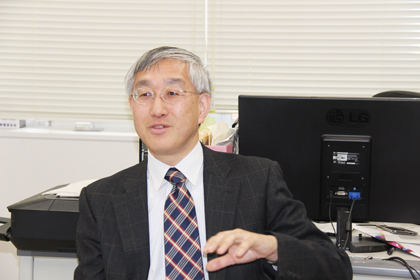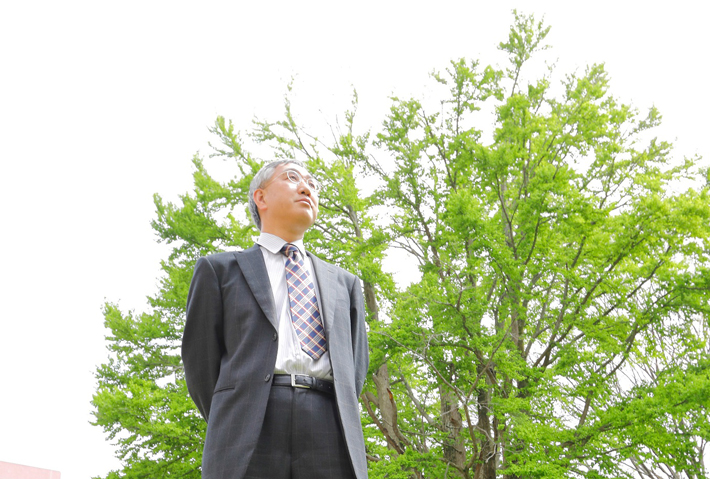TSUKUBA FRONTIER
#18 A Sound Understanding of Basic Properties of Materials Leads the Way to Innovative Energy Technology
The mobile phones, computers, and other portable devices that are such an integral part of our lives are made possible by their compact, high-performance batteries. Strangely enough, however, the mechanisms by which that performance manifests itself are not always sufficiently understood. Prof. Moritomo's research focuses on future technologies by developing a deep understanding of the properties of the materials used in current technologies.
Professor MORITOMO Yutaka, Faculty of Pure and Applied Sciences

■ The mysteriously structured "Prussian blue"

As its name implies, Prussian blue is a dark blue pigment. Discovered in Germany approximately 300 years ago, the pigment has been used as a coloring for painting and ceramics. In Japan, the beautiful blue color became famous through its use by Edo-period painters such as Ito Jakuchu and Katsushika Hokusai.
Several decades ago, Prussian blue became a subject of interest to scientists, who discovered the pigment's unusual crystal structure and pointed out its potential as a high-performance material. One of those possibilities was its use as rechargeable battery electrode material. Prussian blue differs from the typical lithium ion rechargeable battery electrode material, but its structure is clearly understood and the mechanism by which the battery characteristics work is simple, making it an ideal research subject. Research that helps us to understand the previously not-well-understood process of storage battery charge and discharge and to clearly identify its basic materials properties is advancing with the goal of achieving better battery characteristics.
■ Progress toward new technology that goes beyond batteries
One element of this research is the conceptualization of a completely new kind of energy supply known as "thermoelectric batteries." The idea had been developing for many years, and experiments that demonstrated its potential have only recently been published.
Thermoelectric batteries produce electromotive force by converting heat energy from the temperature difference of the battery's cathode and anode to electric energy. Rechargeable batteries need to be charged, but thermoelectric batteries need only a temperature difference between the electrodes to generate electricity. A small ambient temperature difference using factory waste heat or solar energy - and even body temperature - is enough. This technology, which doesn't require any special environment or devices to produce electric power, can use existing battery technology, so development costs are reduced. While not sufficient to replace power plants, this revolutionary technology could be used in portable generators used during natural disasters and other emergencies.
The electrode material used in thermoelectric battery research is Prussian blue. The pigment is promising as a thermoelectric battery material, and key properties and conditions for generating greater thermoelectric power are becoming better understood. If a basic concept can be established, further research and development aimed at practical application is expected to move forward rapidly.
■ Cool and collected persistence pays off

In fact, thermoelectric battery research was put on hold for some time after it was originally proposed. Experiments conducted at the time confirmed that the approach was not mistaken, but the data acquired did not produce the numbers that were hoped for. Prof. Moritomo didn't know then what methods were ideal for obtaining what kinds of data. Trial and error did not give sufficient prospects of success for research to continue in that area.
In hindsight, this is perfectly understandable. With no precedent on which to base research, no references existed as a resource. Several years later, experiments were again attempted using meticulously designed measuring devices, and the result was reliable numbers far better than the original data, spurring new research.
Research always involves this cycle of setbacks and fresh starts. When coming to a dead end, rather than continuing to worry about the problem, the best option is often to step back and take a break to be able to look at it calmly and coolly. That of course doesn't mean abandoning all hope. While Prof. Moritomo works on other topics, feeling and knowledge are refreshed and the research can begin again when the moment presents itself. Confidence in the idea is what enables him to persist in ongoing investigations.
■ The importance of data and publications
Of greatest interest to Prof. Moritomo as a physicist are the properties of materials. Since this interest is not limited to practical application but also includes the discovery of new properties, any material can be the subject matter of research. Prof. Moritomo's battery research began because the unique structure and properties of Prussian blue attracted his interest, but battery characteristics are only one characteristic of many.
The ability to express material properties with numbers and to reproduce results - in other words, the reliability of the results - is of primary importance. In the lab, the first thing Prof. Moritomo teaches the students is to validate data. Confirming data is the foundation of research and the basis on which scientific papers are written.
That is why Prof. Moritomo places such importance on the writing of scientific papers. The value of research lies in the confirmation of data and proof of a logical inquiry into that data in a written article. Research that enables us to thoroughly understand the properties of materials through the accumulation of data and to propose basic principles focused on potential applications and guidelines for development creates the foundation on which future innovative technology is built.

Article by Science Communicator at the Office of Public Relations


